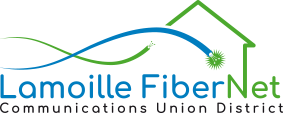When will I be able to get fiber internet service from Lamoille FiberNet? What takes so long?
November 23, 2021 – Well, we are glad you asked! Here are the general steps the Lamoille FiberNet and the other Vermont CUDs (Communications Union Districts) must take to bring “fiber to the premise” (FTTP) and provide high-speed internet service to rural Vermont.
Laying the foundation
- Form CUD, create bylaws, financial policies, procedures, job descriptions, mission statement, insurance, etc. Hire legal counsel. Establish working committees.
- Raise money!
- Feasibility Study – Conduct a survey of interest; contract with industry consultant to assess need, costs, economic feasibility based on financial modeling.
- Evaluate technologies – What internet technologies are proven? Which are future-proof? What are neighboring systems using?
- Create a business plan – What will it cost? How will construction be financed? How will operating expenses be met? What is the expected “take rate” (% of subscribers) in each area?
- Create high-level design system and examine priority areas for build out.
The pre-building process
- Pole study – Determine the ownership, GPS location, condition, height, current attachments (electric, telephone, cable, transformer, etc.) and number of customers served – for every single pole in the service area. Generally, there are about 20-30 poles per mile – and we have 500+ miles of road!
- “Make Ready” – An industry term meaning to decide whether we will need to replace the pole, move some attachments, add poles, etc. Who will do the actual work? What permits, licenses and/or easements are required?
- Mapping hub locations – Hubs are physical structures in the service area that house terminals, power supply, battery backup, internet routers, network switches, etc. – all the things that make the network work.
Partner / Design / Build
- Choose ISP Partner – This is a big one and requires us to assess capability, capacity, and willingness to align with Lamoille FiberNet’s goals. Negotiate cost structure, asset ownership, etc.
- Detailed Design and Engineering Plan – This is the nuts and bolts, planning every inch of the network and building in redundancies and protection.
- Procurement: a) RFP for construction / construction management, and b) buying fiber optic cable, splitters and all other hardware.
- Build, build, build.
Drops, installs and – finally! – customers
- Drops – connect the fiber to the house. How far is the house from the pole? Are wires aerial (overhead) or underground? Is conduit used?
- Installs – Connect the fiber to a router inside the house to create WiFi.
- Then light it up and serve customers!
Though the list above is sequential, the work itself is not – much of it occurs concurrently. For example, Lamoille FiberNet sent out an RFP to potentially interested ISPs, and our Partnership Task Force has been conducting detailed reviews of the responses and interviewing the candidate firms. We just received a $1.19 million grant from the Vermont Community Broadband Board (VCBB) to, among other things, conduct the pole study mentioned above – and Lamoille FiberNet is already working with VCUDA (Vermont’s CUD association) to bulk purchase fiber optic cable and other standard hardware supplies in advance (see Procurement, above).
Throughout the process, Lamoille FiberNet is providing testimony to state legislators, working with state agencies, the VCBB, regional planning commissions, town selectboards, etc. to build consensus and interest and keep the general public informed.
Lamoille FiberNet expects to begin actual construction in Q3 2022 and to begin serving a limited number of customers in Q4 2022.
Submitted by Paul Warden, Johnson representative on the Lamoille FiberNet board.
Lamoille FiberNet’s mission is to make reliable, locally controlled high-speed internet available to every address in our member towns as soon as possible. Serving community, not profit




